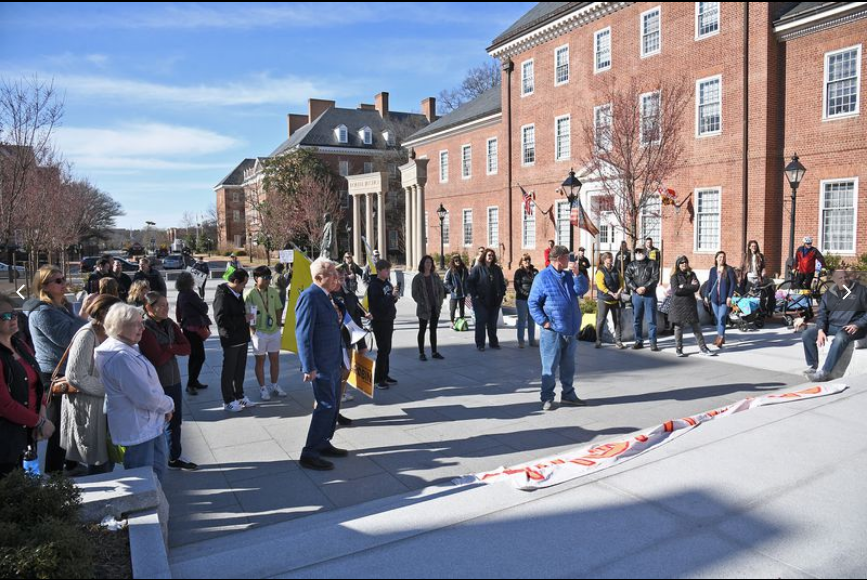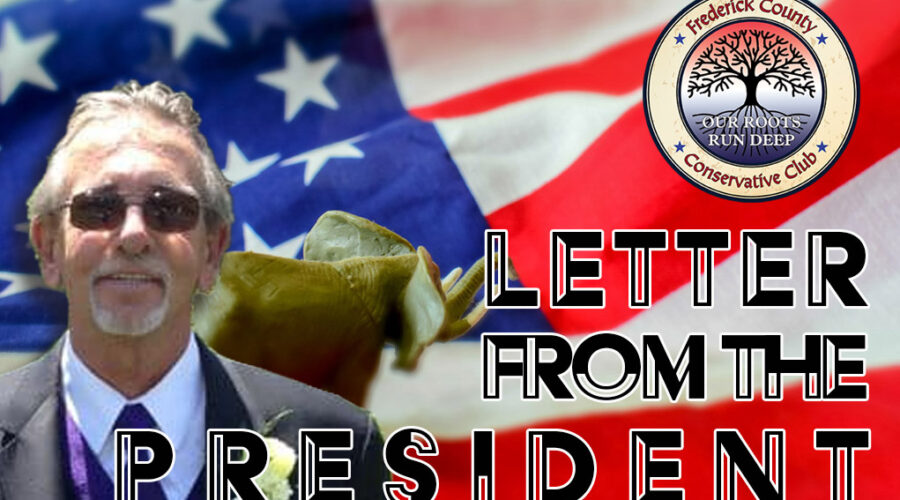Before the coronavirus pandemic took hold in Anne Arundel County, it was common to see friends and neighbors of opposing political parties spending time together, knocking elbows on Main Street for a beer inside a packed restaurant, on the sidelines of a high school football game and around private dinner tables.
But 2020 changed everything. The combination of a charged presidential election and COVID-19, which quickly became a political battle, was tough on many relationships and fatal for others.
For County Executive Steuart Pittman, in one case, it was the latter.
“I had one friend who I always knew politically was different from me, who really came after me over these restrictions just because he really believed in his heart that this was a violation of freedom in a way that just he couldn’t handle it,” Pittman said in an interview with The Capital.
That friend was Brian Riddle, a vocal Anne Arundel conservative and president of Homestead Gardens. The pair got to know each serving together on the Board of the Anne Arundel Soil Conservation District. They grew close despite their differing political views, often sharing meals and the occasional beer together in the years since, Pittman said.
Life changed almost overnight in Anne Arundel County, and Riddle’s anger and resentment grew with every government mandate. Pittman and Annapolis officials, forced by the pandemic, they said, shut down wide swaths of life by requiring businesses to close their doors, limiting interactions with customers and fining organizations that didn’t comply. They attempted to lessen the blow by directing millions into programs to provide emergency aid for rent relief, utility assistance and food services.
Riddle and Pittman’s relationship is an example of the social and political rifts that opened during the pandemic as friends and family often found themselves on opposite sides of the political spectrum when governments began closing and limiting businesses to slow the spread of the coronavirus.
“It definitely drove a wedge,” said Riddle, who confirmed that his friendship with the county executive had taken a turn for the worse during the early stages of the pandemic.
The two disagreed about the decisions Pittman was making and Riddle often took to social media to criticize his former friend as he saw steady business growth disappear.
“I think he makes decisions for a lot of reasons that I just can’t get the logic around,” Riddle said,adding that he still vehemently disagrees with Pittman but could have been more respectful.
Looking back, if circumstances were different, Pittman said he might be critical of another county executive.
“You know there’s a part of me that could easily be there, that if I weren’t in the position I’m in now and I was running my farm I (wouldn’t) like people telling me what I could and couldn’t do when I was running a business, and especially if it cost me my business,” he said.
Government’s response
Two days after Anne Arundel’s first case of COVID-19 was detected in a septuagenarian part-time resident from Montana, and two days after the World Health Organization declared COVID-19 a pandemic, Pittman declared a state of civil emergency in the county.

Though he was given extraordinary powers by the state of emergency provision in the county charter, Pittman was limited in what he could do. Gov. Larry Hogan dictated much of the coronavirus response, holding regular news conferences to announce regulations that local leaders could work within while allowing for stricter choices when needed as each county dealt with differing infection rates.
After the initial spring surge subsided and Hogan began to reopen retail businesses and restaurants, Pittman allowed county establishments to do so at a slower pace and often at a lower capacity than state orders would have allowed. All his decisions, he said, were made under the guidance of public health officials.
When coronavirus metrics began climbing after the presidential election, Pittman moved to restrict indoor dining again after months of allowing them to operate at a limited capacity. Days after he made the announcement, a local restaurant group sued. A judge quickly blocked Pittman’s order, and limited indoor dining was allowed to continue.
After Mayor Gavin Buckley declared a state of emergency in mid-March the city of Annapolis has stayed in lockstep with the county when implementing or loosening COVID restrictions. The lone deviation came in May when Buckley announced that city retailers could allow a limited number of customers inside while the county only allowed curbside pickup/delivery.
Just weeks after the pandemic began, Anne Arundel received a $101 million payout from the federal government to address the crisis. Pittman mobilized the financial resources to help the thousands of county residents who were left without jobs or unable to run their businesses.
The aid was targeted at the county residents behind the 123,838 new unemployment claims that have been filed since March 23. The money was spent to keep desperately needed food banks operating, food delivery programs in action, and ensuring struggling residents remained housed with working utilities. One program Pittman is particularly proud of provided residents who lost income with $500 gift cards. It was initially targeted toward residents who were ineligible for other forms of government aid, like unemployment insurance, but the criteria broadened mid-year and more than 4,800 residents received stimulus in this form.
A slice of the federal aid trickled down to Annapolis, which has used the funds to pay for things like public safety salaries, hazard pay and retrofitting vehicles with cabin shields.
Buckley said,in retrospect,he wishes restrictions happened faster.
“We weren’t sure how serious it was gonna be. I know, in the beginning, I was like, ‘it’s just a cold, right?’” he said. “If we could have shut down things faster, we would have saved more lives.”
Saving lives has been the priority all along, Pittman said. He urged his opponents to try and have empathy for people who have had loved ones fall ill and die. But he doesn’t think that those who disagree with him lack empathy entirely.
“Some people, their empathy lies elsewhere, you know, with the business people who are losing their businesses or the people who are losing their jobs. Everybody’s got their empathy,” Pittman said. “Half a million people dying, to me, in this country is a big deal.”https://cdn.knightlab.com/libs/timeline3/latest/embed/index.html?source=1pa8r0FfU15A0skRoE3jUd4kWIVReKqLj2eV7dzgj7Ek&font=Default&lang=en&initial_zoom=2&height=650
The resistance
Riddle isn’t the only one who has taken issue with Pittman’s handling of the coronavirus pandemic. Critics of the county’s pandemic response began to crop up a few weeks into the lockdown last spring, some of whom spilled into the streets to protest.And that frustration has persisted as recently as Saturday.
Chants to reopen the state rang out from a group of approximately 65 people who gathered across from the State House in the plaza dedicated to Supreme Court Justice Thurgood Marshall. Only a few people wore anything resembling a mask. After all, the protestors yelled, masks don’t work and those that wear them are sheep.
The rally was organized by Trish Stone, one of the cofounders of Return2Learn Maryland Schools, and drew in people from around the state. Stone’s goal with Saturday’s protest was to call attention to the schools, which have started hybrid learning, with some students attending school in person. It has been a year since Stone’s daughter was in a school building, she said.
“Gov. Hogan is going to hear from us again,” Stone said.
Mentions of Dr. Anthony Fauci elicited boos from the crowd. Discussions of the vaccine turned toward anti-vaccination narratives.

The protest attendees knew their numbers were small. Fred Propheter, of Walkersville, Maryland, president of the Frederick County Conservative Club, told the protestors that they needed to bring their friends, family and neighbors to the next assembly.
He was there to protest his rights being taken away, he said. He’s traveled in large crowds multiple times this year, including to the Capitol on Jan. 6, and he is not the healthiest, but he has not gotten the disease.
Propheter is concerned about the restaurants and businesses that have closed during the pandemic. He knows people who have died from COVID-19, and in terms of the 7,856 Marylanders to die from the disease, “it’s a damn shame,” he said. But those people would probably have died from whatever underlying cause the disease amplified.
While the focus was on students who have suffered under the pandemic restrictions, Cynthia Tubaya, of Anne Arundel County, was there for her 97-year-old mother. Tubaya’s mother lives in an assisted living facility and spent the last year in isolation. Her family visited when they were allowed, but holidays and, most recently, her birthday, were spent alone.
“I was crying,” Tubaya said. “It’s sad. It’s really sad.”
Tubaya carried a sign that said her mother is a prisoner.
Her mother is in her last years of life. Tubaya sees little point in having her mother spend those years alone.
“What kind of quality of life is it?” Tubaya said. “It’s not.”
Most were there to reopen schools or for individual rights, including co-founder of Reopen Maryland Tim Walters, who declined to comment.
Walters told the crowd that the government took a “meat cleaver solution to a finesse problem.” Not everyone should have to follow the same regulations, he said.
He won’t insist someone not wear a mask, he said. In return, no one should make him wear a mask.
“This is America,” Walters said. “I’m not responsible for your health.”
For a week or two, residents were willing to give the government the benefit of the doubt, said Herb McMillan, a former Republican Annapolis alderman and state delegate. But as cases continued to rise despite the lockdown, some people started to raise questions.
Of particular focus for McMillan was the delayed reopening of public schools.
That decision wasn’t entirely up to Pittman, though his opinion did have influence and the superintendent and school board did take their cues from Pittman’s Health Officer, Dr. Nilesh Kalyanaraman. In January, Pittman endorsed reopening schools by March 1.
Public school students should have been allowed to return to in-person learning in the fall because scientific research began to show that schools were safe, McMillan said. He sees Pittman’s reticence as a political choice — influenced in part by the county teachers’ union — rather than following science.
Pittman has said a fall surge in cases, which began in early November, made reopening schools impossible at that time.
McMillan hopes there is a reflection on this moment and that more public input will be allowed if lockdowns like this are ever needed again.
County Councilman Nathan Volke, R-Pasadena, has been an advocate for residents like Riddle who are struggling under the weight of the COVID-19 restrictions.
Though Hogan’s reopen strategy largely relied on local leaders to make decisions about the COVID-19 response, Pittman’s powers were not guaranteed.
The County Charter allows Pittman to unilaterally declare a state of civil emergency that lasts for seven days. For the declaration to extend beyond a week, Pittman had to get the approval of the Anne Arundel County Council.
They did so unanimously.
About a month and a half later, Volke made his first attempt to take back his vote. Republicans on the council had grown frustrated with Pittman’s orders and wanted more say in the decisions. But multiple attempts to reduce the executive’s authority failed on party-line votes as Democrats stayed behind Pittman.
An Anne Arundel Community College poll in October found that residents were supportive, but split on the handling of the coronavirus. About 56% of the participants felt that the county reopening pace was about right, and 14% thought the county was reopening too quickly. About a third — 28% — believed Pittman was reopening too slowly.
About half of the participants were content with the measures limiting social gathering or capping the hours for bars and restaurants. More than 80% supported mask-wearing, and nearly 60% supported keeping public school online — though Democrats were generally more supportive of these than Republicans.
Nearly half said they were experiencing unhappiness or emotional distress due to changes related to the virus.
Another poll of Anne Arundel County residents conducted early in the pandemic found that about 51% of respondents found Pittman a trustworthy source of news. Hogan ranked as most trusted at 92%.
‘Forgive each other’
As spring approaches and vaccines reach the arms of county residents, the end of the pandemic could be in sight.
Up late at night, Pittman said his mind is usually circling the issue of the post-pandemic economy and the hundreds of lives lost.
“I see an opportunity to re-engage people and re-engage government in the work of addressing poverty and the trauma that goes along with poverty,” he said.
Friday, Maryland lifted capacity restrictions at restaurants and stores and opened up large indoor and outdoor venues to 50% capacity. Pittman announced Wednesday the county would do the same while maintaining local social gathering and delivery fee limits.
Buckley sees July 4th as a time when a sense of normalcy could start to return to the county with a holiday parade, outdoor dining in full gear and the county’s economy beginning to rev up. The things people took for granted, like a dinner at a restaurant or a parade, will be appreciated after the “strangest year of our lives.”
It’s been a year hot with political strife, but Pittman said he’s hopeful for a natural end to it. He drives through neighborhoods that were just months ago full of Trump signs. With the election over and a new president sworn in, most of them have come down, he said.
“We got past that… And we did COVID during the election season, so those two things at the same time were really, really dividing people,” Pittman said. “You take away COVID and you take away election season, and I think we can forgive each other for disagreeing.”
Riddle sees the end of the pandemic as a chance for the government to be better prepared for the next public health crisis. That could include rebuilding the bridges burned during the pandemic.
“If government would be more of a supporter and an informer and give guidance rather than dictate and tell people what to do, they would gain so much more support, because people would comply,” Riddle said. “At the end of the day, I still respect Steuart. I still hope that one day we can look past it.”
ARTICLE ADAPTED FROM THE : COVID response divided Anne Arundel – Capital Gazette




